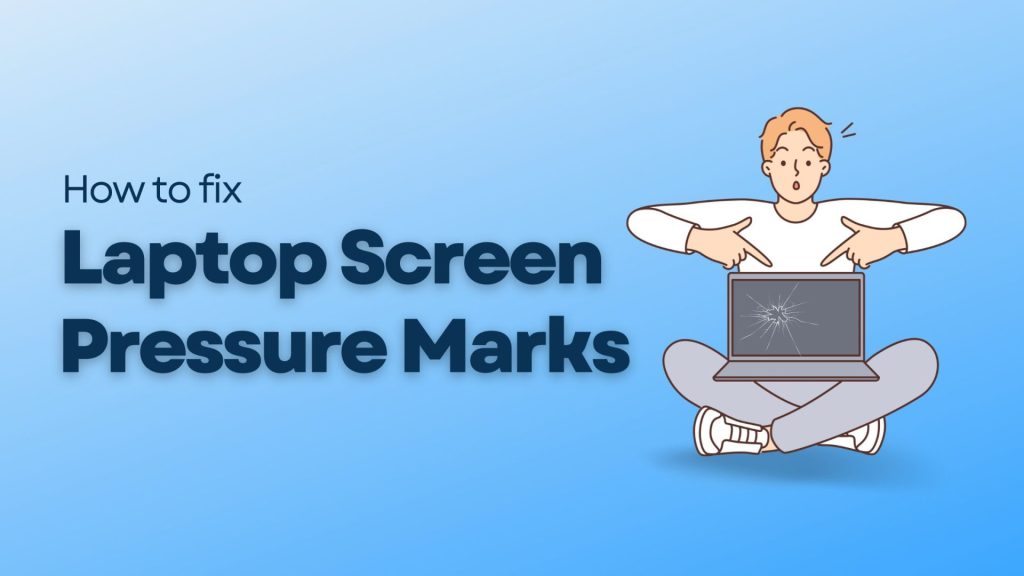Dealing with a damaged laptop screen is frustrating and a potential hazard.
The problem is compounded when pressure patches occur on LCD panels, which may necessitate replacement, causing even more inconvenience.
According to Volza’s Global Export data, 77.1K shipments of laptop screens were exported worldwide. These shipments were made by 2,159 exporters and received by 2,408 buyers.
Depending on the pressure density, pressure spots on LCD panels can take various shapes and forms.
These spots may appear whitish, dark black, or display different hues based on the screen’s current display.
Are you searching for a solution for removing pressure marks from laptop screen? Please keep reading to learn about the causes of pressure spots on LCD panels, effective prevention methods, and practical solutions for fixing them.
How to remove pressure marks from laptop screen? (step by step)
To remove pressure marks from laptop screen 1st Laptop facedown, 2nd Remove the laptop screw, cable, and panel 3rd clean the screen or 4rth verify the screen for How to remove pressure marks from laptop screen.
1. Laptop Facedown
To ensure safety, lay the laptop facedown on a table and ensure it is not connected to any power source.
If the laptop has a removable battery, it’s recommended to remove it before proceeding.
2. Remove the screw or other devices
To access your laptop’s Printed Circuit Boards (PCBs), begin by removing the screws on the rear panel one by one, followed by removing the speakers.
Next, locate the PCBs and detach their screws.
Remember to disconnect the cables linked to the upper PCB. Keep the screws in a designated area for easy retrieval later on.
3. Remove the screen
To remove the screen from your laptop, start by unscrewing it.
Once done, you can utilize vacuum cups to eliminate the LCD.
If you encounter difficulty during this process, it’s advisable to seek assistance from someone.
4. Remove the LCD panel
Upon removing the LCD panel, you will observe several sheets filled with LEDs.
Carefully detach these sheets and keep them in a clean and safe location.
5. Verify Backlight
Now, inspect the sheets and verify that all the LED backlights are appropriately positioned.
If you notice any misplacement, gather the LEDs and reset them in the correct positions.
Subsequently, reverse the entire procedure and carefully adhere to the instructions to reassemble the display.
With any luck, you will not notice any pressure marks on your laptop’s screen.
What is a laptop screen Pressure mark?
A crushed crystal layer located between two glasses comprises the screen.
When physical pressure is applied to the screen, it can result in pressure spots.
The pressure can cause the crystals to lose their solid properties, resulting in the computer’s inability to manipulate them to filter the backlight.
This can even cause the crystals to be displaced from their fixed positions, leading to rotation or twisting.
The issue is noticeable on the screen as blurred or distorted images with incorrect colors.
It resembles a water droplet that has fallen on wet paint.
Which types of Laptop screen damage look like?
When a laptop screen breaks, you’ll observe a range of visual aberrations based on what precisely has been damaged.
These could include stuck or discolored pixels, colored lines, color bleeding, black areas on the screen, or even a complete failure to turn on.
Can we fix the laptop screen lines?
Switch off and then on your monitor.
Though it may seem like a simple solution, it can often resolve screen glitches, such as horizontal lines.
Restart your computer as well.
A quick reboot can resolve various technical problems and eliminate flickering lines on your screen.
Tips before fixing the pressure marks on the laptop screen
1. Check the screen warranty:
The initial step is to verify if the device’s warranty is still in effect.
If it is, the following action is to ascertain whether the warranty includes coverage for the display component.
2. Black spot:
If your screen turns black, it’s not advisable to attempt to remove it entirely by excessively rubbing it.
If you overdo it, the black areas may expand, causing severe damage to your monitor.
3. Expert suggestion:
If you lack the technical expertise or have never repaired a technical device before, it’s advisable to seek assistance from a friend with more experience in this field.

Cause for pressure marks on the laptop screen
1. Excessive Pressure:
Applying too much pressure on the laptop screen can cause harm to the glass sheets and change the physical composition of crystals.
As a result, putting heavy objects on your laptop or applying pressure to the screen can cause pressure marks.
Moreover, laptops may sustain damage during delivery, leading to pressure marks on the screen.
2. Press hard on the screen:
Applying excessive pressure to the laptop screen is one of the most common reasons for pressure marks.
This usually occurs when people use a touchscreen laptop and inadvertently exert too much pressure on the screen.
Even if this is unintentional, the screen may not be able to endure such excessive force, resulting in pressure marks.
Some other common problems with LCD screen
3. Flickering:
If you notice sudden flashes on your monitor when turning it on, it may be due to a loose video cable.
In most cases, tightening the cable will solve the issue.
However, ensure that you are not using a faulty cable.
If the cable is damaged, purchasing a new one and replacing it is advisable.
4. Vertical line:
If you notice sudden flashes on your monitor when turning it on, it may be due to a loose video cable.
In most cases, tightening the cable will solve the issue.
However, ensure that you are not using a faulty cable.
If the cable is damaged, purchasing a new one and replacing it is advisable.
5. Pixel dead:
A black spot visible on the screen can often be permanent and occurs when a portion of the screen is not illuminated.
Although the mark does not damage the screen, it cannot be enjoyable to have it present.
Fortunately, there is software available that can help rectify the issue.
This software operates by rapidly changing colors in the area with the dead pixel.
6. Resolution inappropriate:
At times, we may not be aware of an automatic change in our screen resolution.
Such a change may be caused by a faulty graphics card, which requires replacement to resolve the issue.
However, before considering replacement, updating your graphic drivers may offer a potential fix.
If this doesn’t solve the problem, attempting to change the port, similar to changing the battery or charger, could be an alternative solution.
7. Physical damage:
Physical damage to screens is a common occurrence, such as when the screen falls off a table, when liquid accidentally spills on it, or when fractures occur.
Unfortunately, some instances, like when a child strikes the screen with a sharp object, cannot be repaired.
In such cases, the only viable solution is to replace the screen.
8. Slight buzzing sound:
Do you hear a slight buzzing sound when using your computer? This may indicate an issue with the display’s backlights.
Fluorescent lighting tubes, commonly used in earlier monitors, were prone to failure.
While the current LED displays are more efficient and reliable, power fluctuations can still cause noise.
If you experience frequent power outages, consider using a voltage regulator near your computer to stabilize the power supply.
9. Intermittent display random shutdowns:
Many users often experience the issue of intermittent display shutdowns, which power fluctuations may cause.
It is essential to ensure that your home’s main power supply is functioning correctly and that the circuit breaker is not tripped regularly.
If this is the case, the main electricity supply may be the root cause. Overheating is another factor that can cause screen shutdowns.
Therefore, it is crucial to keep your device cool to prevent this problem.
Can we ruin the LCD screen by pressing on it?
While excessive pressure on LCDs can cause swirls and whorls, it is unlikely to cause any long-term damage.
How to prevent pressure marks from the laptop screen?
1. Keep in a Safe place:
No matter if you possess an LCD TV, laptop, or desktop monitor, it’s crucial to place it in a secure location.
2. Be gentle with the touch screen:
While cleaning your LCD panel, exercise caution and exclusively use a soft cloth to touch the panel.
Applying excessive pressure to the panel can lead to damage.
3. Use a screen protector:
Employing a screen protector is a prudent measure to safeguard your display against any unintended mishap.
This minimizes the dangers associated with installation and cleaning.
4. Don’t put heavy stuff:
To prevent pressure spots from forming on your display, avoid placing anything heavy on top of it, even something as light as a book.
If you want your LCD screen to endure for a prolonged period, ensure that heavy objects are kept at a safe distance from it.
How we will know if we got dead pixels on the laptop screen?
In the event of dead pixels on your display, you’ll notice black spots on the screen.
If only a few pixels are dead, they might go unnoticed.
However, when multiple pixels die, black spots become apparent.
Sadly, the spot is a prevalent issue with LCD monitors, and managing dead pixels requires excellent care.
How to fix the laptop screen mark made by the laptop keyboard?
To remove marks on the screen, utilize nail polish remover.
However, it’s not advisable to apply it directly to the screen.
Instead, dab a small amount of nail polish remover onto a cloth and use it to wipe off the marks on the screen gently.
The marks should come off quickly.
Can the laptop screen pressure mark go away?
Pressure spots may also result from manufacturing defects, manifesting as dark or bright spots on display.
While these blemishes may dissipate on their own within a few days in some instances, they may be permanent in others.
The final conclusion
This article will discuss practical solutions how to remove pressure marks from laptop screens.
Pressure spots on LCD panels occur due to mechanical strain, which flattens one of the surfaces of the display.
While several methods address various pressure points, the recommended tips for each category can expedite the process.
It is worth noting that methods for removing pressure spots from LCD screens are generally safe, so don’t hesitate to experiment with them.

Metscope is a leading supplier of Color Coated Steel Roofing Sheets, Aluminium Roofing Sheets, Asphalt Shingle Roofing, PUF Sheet, Fiber Cement Board, Purlin, Deck Sheet, Thermal Insulation Sheet, Polycarbonate sheet, Roof Ventilators, Accessories.